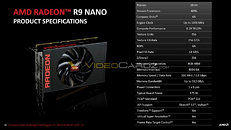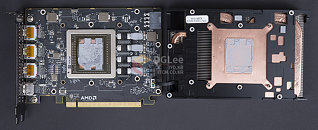Tuesday, August 25th 2015

AMD Radeon R9 Nano Core Configuration Detailed
AMD's upcoming mini-ITX friendly graphics card, the Radeon R9 Nano, which boasts of a typical board power of just 175W, is not a heavily stripped-down R9 Fury X, as was expected. The card will feature the full complement of GCN compute units physically present on the "Fiji" silicon, and in terms of specifications, is better loaded than even the R9 Fury. Specifications sheet of the R9 Nano leaked to the web, revealing that the card will feature all 4,096 stream processors physically present on the chip, along with 256 TMUs, and 64 ROPs. It will feature 4 GB of memory across the chip's 4096-bit HBM interface.
In terms of clock speeds, the R9 Nano isn't too far behind the R9 Fury X on paper - its core is clocked up to 1000 MHz, with its memory ticking at 500 MHz (512 GB/s). So how does it get down to 175W typical board power, from the 275W of the R9 Fury X? It's theorized that AMD could be using an aggressive power/temperature based clock-speed throttle. The resulting performance is 5-10% higher than the Radeon R9 290X, while never breaching a power target. Korean tech blog DGLee posted pictures of an R9 Nano taken apart. Its PCB is smaller than even that of the R9 Fury X, and makes do with a slimmer 4+2 phase VRM, than the 6+2 phase VRM found on the R9 Fury X.
Sources:
VideoCardz, IYD.kr
In terms of clock speeds, the R9 Nano isn't too far behind the R9 Fury X on paper - its core is clocked up to 1000 MHz, with its memory ticking at 500 MHz (512 GB/s). So how does it get down to 175W typical board power, from the 275W of the R9 Fury X? It's theorized that AMD could be using an aggressive power/temperature based clock-speed throttle. The resulting performance is 5-10% higher than the Radeon R9 290X, while never breaching a power target. Korean tech blog DGLee posted pictures of an R9 Nano taken apart. Its PCB is smaller than even that of the R9 Fury X, and makes do with a slimmer 4+2 phase VRM, than the 6+2 phase VRM found on the R9 Fury X.


101 Comments on AMD Radeon R9 Nano Core Configuration Detailed
Otherwise, it's a dog turd like Fury X.
AMD are clearly marketing the card for SFF applications, but I doubt too many reviews - if any, are going to use a SFF test environment (maybe an open air version at best).
For example, my HD7950, I could overclock it from stock 900MHz to 1000MHz without any voltage change (stock 1075mV I think). For 1100MHz I needed around 1.2V, for 1200MHz it was at 1.38V even though I've made the same 100MHz increase as before.
Anyway, the point I'm making is that voltage isn't receiving linear increase with same clock increases. Once you get to a certain point, voltages have to skyrocket in order to maintain linear clocks increase.
Maybe 1050MHz is already that point for Fiji (used on Fury X), that's why it needs water cooling and we know how power usage spiked on overclocks. But Nano is clocked 50MHz lower and that gives it all the headroom to lower the voltages. It just won't be a mad overclocker due to power circuitry limitations.
but for those who have other plans ( 2016 plan ), then waiting for HBM2 will be interesting, not because AMD will be able to have 8GB and more of VRAM... but we will be able to see both AMD and NV offerings also...
I'll be very interested in Nano like products, Nano 2 from AMD or what ever NV will come with will be interesting for my next build which should be a miniITX build... hell we might get AMD Zen also in the mix to see how it will do against Skylake or Kaby Lake as we're looking at 2H16 timeframe
@john_ Firing the marketing team isn't going to change the mentality at AMD, even though the bad marketing is at the centre of their problems. They've made countless mistakes over the past 4 years alone, and now it's as if every part of AMD is adopting an unmotivated, slacking, waiting-for-the-end attitude.
I have a few concirns about HBM1 since it cant go above 4GB, so Im waiting for HBM2 instead, and I dont feel like any of the Fury series will bring a lot to the table over my R9 290 from Sapphire, since my card gives even the new series a run for its money especially if I turn up the juice on it.
But the Nano might do it fore me;), so I will upgrade, especially under water and turn up the juice, I have the itch for new hardware:eek:. I really dont need any new hardware, but the feeling in the right fingertip is becomming close to hit the buy button:toast::nutkick:.
And please dont start with the 8GB nonsense, its a marketing gag (GT620 4GB much). For single GPUs setups it's useless in most cases - Hawai doesnt have the horsepower to make use of it. Hawai (290/390) and 970/980 are 1080/1440p cards.
I was really hoping for a 970 alternative to replace my GTX570.
Overclocking on this card is going to be nonexistent because it will probably catch fire, but that's okay because Fury/Fiji overclocks like s**t anyway, so why would you even bother.